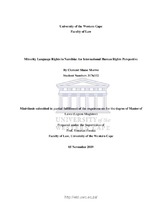| dc.description.abstract | Namibia is home to a number of linguistic minorities. According to the 2011 census, the
Owambo constitute 49.35 per cent of the population, accounting for almost half of the country’s
total population.1
The rest of the linguistic groups include the Bushman (San) (0.95 per cent),
Caprivians (4.5 per cent), Herero (8.99 per cent), Kavango (10.42 per cent), Damara/Nama
(11.32 per cent), Setswana (0.26 per cent), Afrikaans (8.72 per cent), German (0.54 per cent),
English (2.43 per cent), other European languages (0.69 per cent), other African languages (1.74
per cent), Asian languages (0.08 per cent) and other unidentified languages (0.02 per cent).2
English is, however, the only official language in terms of the Constitution of the Republic of
Namibia, 1990 (“Constitution”).3 | en_US |

